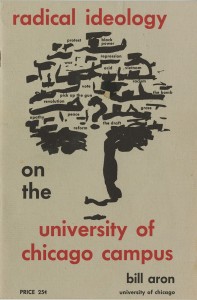Anger resulting from a decade of controversial policy decisions in Vietnam combined with the revolutionary wave of the counterculture created the ideal circumstances for widespread antiwar demonstrations. In the 1960s, this growing peace movement originated largely on college campuses. Students took to the streets, expressing their disapproval of the Vietnam War, President Richard Nixon, and the draft.
Many college-aged protesters exercised their right to assemble via student organizations and on-campus clubs, such as the Students for a Democratic Society (SDS) and the American Students Union (ASU). These groups fought against American militarism and, in addition to their antiwar activities, also advocated for a more egalitarian society and leftist economic policies. Printing their own literature and developing their own political philosophies, organizations such as these facilitated expressions of dissent and allowed American youth to put their opinions into print.

Some protesters went to extreme measures to advocate for the antiwar cause. Roger Allen LaPorte set himself on fire in front of the United Nations building in New York City on November 9, 1965. The New York Times reported LaPorte “soaked himself with gasoline and set himself aflame…to protest against ‘war, all war.’” LaPorte was not the first or the last to use self-immolation in protest of the war.
One of the most pervasive manifestations of the antiwar movement – both on and off college campuses – involved the burning of draft cards. These displays were usually public and incredibly controversial, even among those who opposed the draft. Though generally only draft cards and flags were burned, a few protesters took the drastic step of setting their own bodies on fire.

Student demonstrators frequently engaged in disruptive activities, prompting police to shut down their protests. Students objected to many components of the Vietnam War including the military recruitment of students, the use of napalm in combat, and the draft.
At Oberlin College in Ohio, student demonstrators surrounded a car belonging to a Navy recruiter in October 1967, trapping the recruiter for hours before police arrived to liberate him. Students often engaged with militarist institutions on their own campuses most viciously, as they had the most immediate impact on the students themselves. ROTC programs, military recruiters, and war research curriculums became common targets as students across the nation challenged their campuses’ contributions to the war effort.
College faculty engaged with student protesters in a number of ways. Some took an active role in encouraging students and helping them to organize, while others expressed their disapproval of the upheaval created by student protest. A few professors (and graduate students such as Bill Aron of the University of Chicago), attempted to document the student movement on their campuses. These scholars, like their students, understood the historical implications of the times in which they were living.

This pamphlet was published by Bill Aron at the request of a sociology professor at the University of Chicago. Based on Aron’s graduate thesis, which included a survey of the ideology of youth, the pamphlet covers topics such as race, revolution, violence, Vietnam, and protest.
Though colleges earned a reputation for housing antiwar activists, not all students opposed the war. Some American college students were members of what Richard Nixon called “the silent majority” – those who quietly supported intervention in Vietnam. Others advocated openly for continued American involvement, engaging in demonstrations of their own. Conservative student organizations such as Young Americans for Freedom formed in opposition to the growing leftist antiwar movement, organizing counter-protests that appealed to American patriotism and expressed their support for the war effort and the soldiers who waged it.
